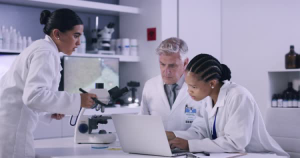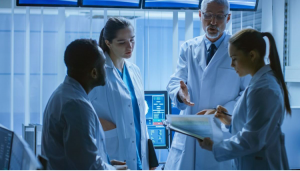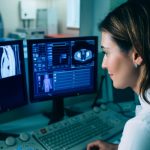5 Ways Digital Health Technology Enhances Laboratory-to-Laboratory Communications
Effective communication is the cornerstone of operational success in almost every industry, but nowhere is this more evident than within the realm of medical laboratories, the forefront of digital health technology.
Consider the gravity of the situation: patient samples, diagnostic outcomes, and medical insights navigating a complex network of data pathways. Any delay or inaccuracy in communication can have profound implications, directly impacting patient care, treatment plans, and the overall reliability of laboratory operations.
Laboratories are essential pillars of contemporary medicine, where meticulous analysis and precise diagnostics underpin quality healthcare delivery. However, behind this facade of seamless operation lies the intricate challenge of inter-laboratory communication, spanning both intra-institutional and inter-facility contexts.
Here, digital healthcare technology emerges as a pivotal force for change. Through its transformative capabilities, it can help to smooth the complexities of lab-to-lab communication. By streamlining processes and enhancing accuracy, healthcare tech enables an environment where seamless data exchange between laboratories is not merely an aspiration, but an attainable reality.
The Critical Nature of Handling Patient Samples and Results
Laboratories shoulder the responsibility of analysing a diverse array of patient samples, each representing an individual seeking answers and treatment. From blood tests to tissue biopsies to genetic analyses, these samples yield invaluable insights crucial for medical decision-making. Timely delivery of test results is paramount, enabling clinicians to promptly diagnose and treat patients. Any lapse in communication, no matter how minor, can trigger a cascade of complications. Mishandled samples may lead to misdiagnoses or delayed treatment, while inaccurate or delayed test results can impede informed decision-making, impacting patient recovery and care.
Navigating the intricate realm of laboratory communication and health information technology demands a holistic approach that tackles challenges head-on and embraces innovative solutions. Here, we delve into five key strategies to ensure seamless laboratory-to-laboratory communication:
- Embrace clear and effective communication to ensure critical information is relayed in a timely and accurate manner.
- Leverage digital health technology for streamlined sample tracking and storage.
- Reduce the risk of manual errors and increase efficiency with 2D barcoding technology.
- Foster cohesive information and full-circle communication for accuracy in matching lab requests and results, ensuring full traceability and completeness in the requesting Laboratory Information System (LIS).
- Ensure communication channels are secure and encrypted to keep confidential information safe.
By understanding and implementing these five strategies, laboratories set the foundation for seamless communication, enhancing patient care, optimising lab operations, and contributing to the overall advancement of healthcare.
Let’s take a closer look at each strategy, including what it entails and how digital health technology can help enhance lab-to lab communication.

Clear and Effective Communication for Critical Information
In the modern world with technology advancements at every corner, it’s important to reap the benefits of health information tech for accurate and timely healthcare communication. Laboratories play a pivotal role in the diagnostic process, and the information they handle holds the key to patients’ health outcomes. From initial sample order and collection to the delivery of test results, each step in the laboratory workflow relies heavily on effective communication.
Accurate communication ensures that pertinent information about patient samples, test requests, and results is conveyed without error or delay, enabling healthcare professionals to make informed decisions promptly. Whether it’s a routine test or a critical diagnosis, this communication is vital to expedite patient care, reduce waiting times, and improve treatment efficacy.
On the other hand, when miscommunication occurs in the laboratory setting, the consequences can be severe and far-reaching. Inaccurate documentation of patient samples or test requests can lead to sample mix-ups or delays in testing, potentially resulting in misdiagnoses or inappropriate treatments. Such errors not only jeopardise patient safety, but also contribute to increased healthcare costs and operational inefficiencies.
That’s why laboratories must establish clear channels and well-defined protocols for data sharing. Embracing a standardised approach to communication minimises the risk of misinterpretation or misplacement of information. This means implementing robust communication systems and ensuring that all stakeholders, including laboratory technicians, clinicians, and support staff, are trained to use these systems effectively.
Investing in modern laboratory communication technologies and integration solutions is a must to facilitate the transmission of information between different departments and healthcare facilities. These technologies streamline the communication process, reduce manual entry, and enhance the overall efficiency of lab operations. From electronic sample tracking to automated reporting, advanced systems provide timely results improving the coordination between laboratories.

Leveraging Digital Health Technology for Sample Tracking and Storage
Technology can play a major role in streamlining lab-to-lab communications, especially when it comes to sample tracking and storage. Digital health technology solutions, like DMF Systems’ Laboratory Sample Tracking and Results Archiving Solution (STARS) revolutionises the way laboratories manage their sample tracking and archiving processes.
Traditionally, the management of lab samples was a time-consuming and error-prone process, with extensive paperwork and manual documentation. STARS, a comprehensive software solution, eliminates the need for manual methods, enabling laboratory scientists and technicians to record and manage samples more efficiently through barcode scanning. It is designed to simplify the entire lifecycle of lab samples from the moment they are collected to their final archiving and retrieval. Serving as a central hub for managing the movement of samples within and between laboratories, STARS provides a complete chain of transparent and auditable custody records, and provides real-time updates and notifications, keeping stakeholders informed about the samples’ status. Laboratory staff can effortlessly generate electronic Proof of Delivery (POD) notifications, ensuring that samples are tracked and validated throughout their journey. Such meticulous tracking not only enhances sample security but also instils confidence in the integrity of results. This system not only enhances data accuracy but also expedites the movement of samples, leading to faster turnaround times and improved patient care.
Cryogenic storage, essential for preserving valuable biological samples, presents its unique set of challenges. STARS integrates advanced technology to streamline cryogenic storage processes, ensuring secure and efficient archiving of samples. With STARS, laboratories can confidently store and retrieve samples from cryogenic storage units, minimising the risk of mishandling or misplacing crucial samples. This also optimises inventory management. Laboratory staff can easily locate and retrieve samples as needed, reducing retrieval time and enhancing overall operational efficiency. This level of control and accessibility fosters a sense of confidence in the integrity of stored samples, leading to improved research outcomes and better patient care.
Reducing Manual Errors with 2D Barcoding Technology
As in many industries, manual data entry in laboratories can become a significant hurdle. Laboratory technicians juggle numerous tasks while meticulously transcribing sample information and test requests into the Laboratory Information System (LIS). The manual process is susceptible to human errors, leading to potential mislabelling, data inaccuracies, and delayed test results. Such mistakes not only undermine lab efficiency but can also compromise patient safety and care.
With digital healthcare solutions like 2D Barcode Requesting, the issues of manual data entry are no longer a concern. This innovative technology revolutionises the sample scanning process by utilising 2D barcodes that encode comprehensive information in a small pattern. With a quick scan, laboratory technicians can capture patient demographics, test requests, and more, eliminating the need for manual entry. Rapid and error-free scanning expedites sample processing makes 2D Barcode Requesting especially ideal for population screenings and clinical trials.
By removing the reliance on manual data entry, the 2D Barcode Requesting process simplifies and standardises data input, mitigating the risk of human errors, ensuring data accuracy, and boosting efficiency. Technicians can redirect their efforts towards other critical tasks, reducing turnaround times and improving overall productivity. Moreover, accurate data capture from the barcode ensures consistent and error-free information, leading to enhanced patient safety and informed decision-making by healthcare providers. By embracing this innovation, laboratories can achieve greater accuracy, expedite processes, and ultimately enhance patient safety. The implementation of 2D barcoding represents a leap forward in health information tech, empowering healthcare professionals to deliver top-notch care and diagnostics.
Fostering Cohesive Information and Full-Circle Communication with Digital Health Technology
Accurate matching of lab requests and results is crucial for effective laboratory communication. Each sample comes with specific test requests, and the corresponding results provide vital diagnostic insights. Ensuring precise pairing of these requests and results is essential for reliable patient care and informed medical decision-making. Mismatched lab requests and results can lead to confusion, treatment delays, and compromised patient safety. Healthcare providers heavily rely on laboratory data for diagnosis, treatment monitoring, and therapy decisions. Accurate matching ensures smooth continuity in patient care.
Advanced digital health technology, such as DMF Systems’ LIS2LIS integration, plays a pivotal role in achieving full traceability and completeness in laboratory communication. This integration allows automatic transmission of test requests and results between different LIS systems, eliminating the need for manual data entry and ensuring secure electronic data interchange. By automating data capture and leveraging 2D barcodes, laboratories enhance data accuracy, minimising errors and omissions. STARS and 2D Barcode Requesting facilitate comprehensive tracking and accurate recording of sample movements and test results. This digital transformation ensures that no critical step in the sample’s journey is overlooked or undocumented.
The seamless integration of LIS2LIS, STARS, and 2D Barcode Requesting streamlines the entire workflow, from sample collection to archiving, enhancing efficiency and accuracy. This synergy minimises discrepancies and ensures precise matching of lab requests and results, enabling laboratory staff to focus on delivering high-quality services while maintaining patient safety and data integrity.
Securing Lab Requests and Results with Encrypted Communication
Laboratory data contains sensitive and confidential information about patients, and thus requires the highest level of protection. Healthcare providers, patients, and regulatory bodies place immense trust in laboratories to safeguard this information. Any breach in data security can not only lead to reputational damage but also pose significant legal and ethical implications. Therefore, ensuring the confidentiality of lab data is not only an obligation but a moral responsibility.
Traditional communication methods, such as unencrypted emails or paper-based reports, are vulnerable to security breaches. Unsecured communication channels create opportunities for unauthorised access, interception, or tampering with sensitive lab requests and results. Cyberattacks and data breaches have become increasingly common, targeting valuable medical data for malicious purposes, as everyone working in the HSE is acutely aware since the 2021 ransomware cyber-attack.
Furthermore, unsecured communication can lead to data loss, compromise patient privacy, and hinder efficient coordination between laboratories and healthcare providers. The potential consequences of such risks underscore the critical need to implement secure communication channels.
To mitigate the risks associated with unsecured communication, laboratories must adopt secure and encrypted communication channels. Encryption transforms lab data into unreadable code during transmission, making it inaccessible to unauthorised parties. This robust security measure ensures that lab requests and results remain confidential and protected.
Leveraging modern digital health technology, laboratories can integrate encrypted communication solutions into their existing workflows. Secure portals, virtual private networks (VPNs), and encrypted messaging applications are among the tools available to safeguard sensitive data during transmission. These solutions not only protect against external threats but also prevent internal data leaks.
Secure, encrypted communication not only safeguards lab data but also ensures data integrity. By verifying the authenticity and origin of transmitted information, laboratories can maintain the accuracy and reliability of lab requests and results. Data integrity is vital in providing healthcare providers with complete trust in the diagnostic insights they receive.
Moreover, secure communication channels uphold patient privacy, promoting compliance with data protection regulations such as the General Data Protection Regulation (GDPR). Patients can have peace of mind knowing that their sensitive health information remains confidential and is only accessible to authorised personnel.
Secure, encrypted communication for lab requests and results is imperative for laboratories. By acknowledging the confidential nature of lab data and taking proactive measures to secure communication channels, laboratories maintain data integrity, protect patient privacy, and build a foundation of trust among stakeholders. Embracing encryption technology ensures that laboratory-to-laboratory communications remain resilient and safeguarded against potential threats, fortifying the future of healthcare information tech security.
A Holistic Digital Health Technology Approach to Laboratory Communications
The five essential strategies outlined above are the keys to achieving successful laboratory-to-laboratory communication. Embracing effective communication for critical information lays the foundation for accurate data transmission. Leveraging technology, such as STARS and 2D Barcode Requesting, streamlines sample tracking, reduces errors, and ensures smooth movement across locations. Fostering cohesive information and full-circle communication allows laboratories to enhance accuracy and traceability. Finally, implementing secure, encrypted communication protects sensitive data, upholds patient privacy, and fortifies data integrity.
As technology continues to evolve, the future of health information tech and laboratory communications is filled with promise. Automation, artificial intelligence, and real-time data analytics hold potential for further optimising laboratory operations and enhancing patient care. Laboratories that proactively invest in cutting-edge solutions and adopt emerging technologies will be at the forefront of delivering superior diagnostics and patient outcomes.
To learn more about how digital healthcare technology can improve lab-to-lab communications now and for the future, get in touch with DMF Systems today!






